

User Profile: John Socha-Leialoha - Nightly. Rostock - RepRapWiki - Nightly. On 3D Delta Printers.... - Nightly. 3D Printer Plans - Nightly. Jonathan Keep has developed his own ceramic 3D printer after he was annoyed and frustrated by 3D Systems buyout and subsequent closing down of production of the RapMan 3D printer.
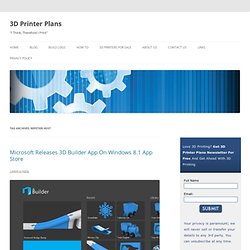
The RapMan was developed by Belgian design studio, Unfold and it was the first kit printer to use clay as a printing material. Keep used a Delta type design for his 3D printer. He said “my aim has been to use parts that can either be made with basic DIY tools and skills, or ordered off the internet. The design is specifically for printing in clay but could be adapted to work with other materials. Many other self build 3D printers use parts printed in plastic but with this project I did not want to be reliant on already having access to a 3D printer.” According to Keep the information on his website is not blue print’s for the printer, but rather a documentation of the design of it. 3D Printer Plans - Nightly. Kossel - RepRapWiki - Nightly. Kossel Release status: experimental Kossel is a parametric delta robot 3D printer, built in 2012 by Johann in Seattle, USA, based on his Rostock prototype.
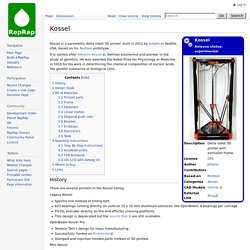
It is named after Albrecht Kossel, German biochemist and pioneer in the study of genetics. He was awarded the Nobel Prize for Physiology or Medicine in 1910 for his work in determining the chemical composition of nucleic acids, the genetic substance of biological cells. History There are several printers in the Kossel family. Legacy Kossel Spectra line instead of timing belt. 623 bearings running directly on vertical 15 x 15 mm aluminum extrusion like OpenBeam, 6 bearings per carriage. OpenBeam Kossel Pro Terence Tam's design for mass manufacturing. Mini Kossel This is Johann's latest and stable version. Design Goals Zero backlash. Optionally scale down to a Traveling RepRap that fits within IATA hand luggage size limit (see transportation): 3DR RepRap Delta Printer - Part 1 - Release - Mini Maker-Faire London - Nightly. Hello Everyone,This post sees the release of my 3DR Delta printer design.
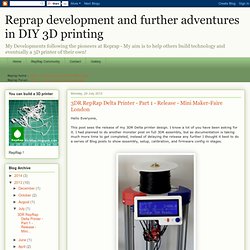
I know a lot of you have been asking for it. I had planned to do another monster post on full 3DR assembly, but as documentation is taking much more time to get completed, instead of delaying the release any further I thought it best to do a series of Blog posts to show assembly, setup, calibration, and firmware config in stages. 3DR (V2_001) Release. 3DR attracted a lot of attention for the entire Maker-Faire day, much more than I expected. Here are a few photo's of some of the objects we printed using the fine filament faberdashery provided to all exhibitors during the faire. This was a popular one - the colours mix between clear at the bottom, bands of increasing rainbow and gold eventually fading into silver. - Print time of 67mins / 0.125mm layers @ 105mm/sec 0.3mm mixing nozzle. A Joris Weekly cup (Nr22) printed in Bling Bling Gold, mixed with various rainbow colours. Special thanks to - Johann C. Rostock 2012. Terawattindustries / rostock-delta-robot / changesets.
Bill Of Materials - Rostock. Hoss's 3D Printers - Page 69. Drew's Rostock: Drive Axis. The Rostock style 3D printer differs from more conventional designs in having three identical drive axis, all moving in the Z direction, which move the print head with a complex 6-bar linkage.
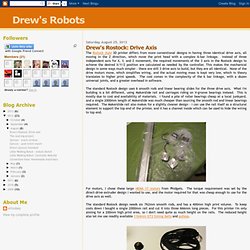
Instead of three independent axis for X, Y, and Z movement, the required movements of the 3 axis in the Rostock design to achieve the desired X/Y/Z position are calculated as needed by the controller. This makes the mechanical design in some ways much simpler - there are still 3 drive axis to build, but they are all identical. None of the drive motors move, which simplifies wiring, and the actual moving mass is kept very low, which in theory translates to higher print speeds.
The cost comes in the complexity of the 6 bar linkage, with a dozen universal joints, and a greater overhead in software. The standard Rostock design uses 6 smooth rods and linear bearing slides for the three drive axis. For motors, I chose these large NEMA 17 motors from Phidgets. John Ecker - Google+ - My vision on what the Rostock 3D printer delta bot(by…
Billy D's Rostock 3D Printer. (70) Delta robot 3D printers. Rostock. Rostock (delta robot 3D printer) by Johann. Blog with project history: Videos: More pictures: More details about parts: OpenSCAD source files: Documentation: Ask questions here: Rostock is a delta robot 3D printer prototype with the following design goals: Build volume: 8x8x16 inches or 200x200x400 mm Footprint: 12x14 inches Print surface: 8x8 inches heated glass which never moves Mass of end effector with two hotends: less than 150g Positioning speed: 800 mm/s in all 3 directions Positioning accuracy: at least 30 steps/mm in all 3 directions Simplicity: fewer than 200 parts (not including washers, nuts and SMD-mounted electronics) Hardware cost: less than $500 USD Inspiration: search YouTube for "flexpicker" or "adept quattro".
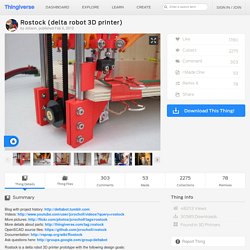
Closest ancestor: Documentation: I'm also uploading Rostock parts as separate things, to make it easier to post specific instructions, comments and derivatives: July 17 update: The 3 bottom micro switch endstops are going away in the next release, because the top endstops are already micro-adjustable. Rostock.